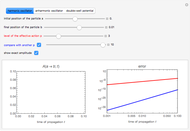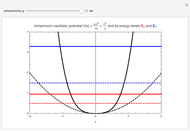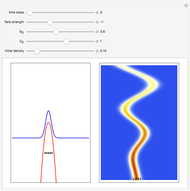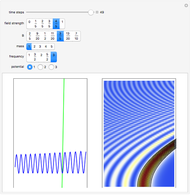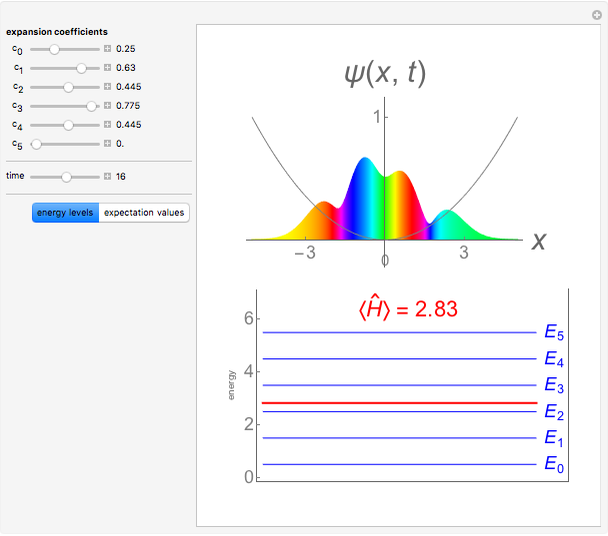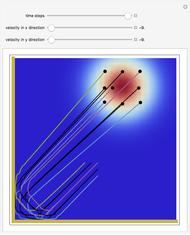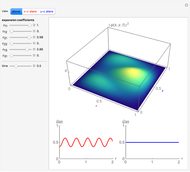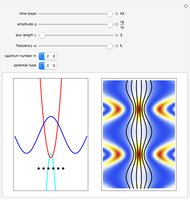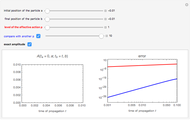Short-Time Expansion of Amplitudes for Time-Dependent Potentials

Requires a Wolfram Notebook System
Interact on desktop, mobile and cloud with the free Wolfram Player or other Wolfram Language products.
In this Demonstration we show that short-time quantum-mechanical transition amplitudes can be very accurately calculated if their expansion in the time of propagation is known to high orders. Here we consider imaginary-time amplitudes for the one-dimensional forced harmonic oscillator, with the time-dependent potential  . For a quantum system in a time-dependent potential, the probability of a transition from an initial state
. For a quantum system in a time-dependent potential, the probability of a transition from an initial state  to a final state
to a final state  in time
in time  is equal to
is equal to  , where
, where  is the transition amplitude. The evolution operator has to take into account explicit time-dependence of the potential. In a recently developed effective action approach, the amplitude is expressed in terms of an effective potential, and a set of recursive relations allows the systematic analytic derivation of the terms in the expansion of the effective potential in time t. The effective action thus obtained is characterized by a chosen level
is the transition amplitude. The evolution operator has to take into account explicit time-dependence of the potential. In a recently developed effective action approach, the amplitude is expressed in terms of an effective potential, and a set of recursive relations allows the systematic analytic derivation of the terms in the expansion of the effective potential in time t. The effective action thus obtained is characterized by a chosen level  corresponding to the maximal order
corresponding to the maximal order  in its expansion. If level
in its expansion. If level  effective action is used, errors in the calculation of the transition amplitudes are proportional to
effective action is used, errors in the calculation of the transition amplitudes are proportional to  .
.
Contributed by: Antun Balaz (March 2011)
After work by: Antun Balaz, Ivana Vidanovic, Aleksandar Bogojevic, Aleksandar Belic, and Axel Pelster
Open content licensed under CC BY-NC-SA
Snapshots
Details
The effective action approach was originally developed in a series of papers:
[1] A. Bogojevic, A. Balaz, and A. Belic, "Systematically Accelerated Convergence of Path Integrals," Phys. Rev. Lett., 94(18), 2005.
[2] A. Bogojevic, A. Balaz, and A. Belic, "Systematic Speedup of Path Integrals of a Generic N-Fold Discretized Theory," Phys. Rev. B, 72(6), 2005.
[3] A. Bogojevic, A. Balaz, and A. Belic, "Generalization of Euler's Summation Formula to Path Integrals," Phys. Lett. A, 344(2–4), 2005 pp. 84–90.
The extension of the approach to many-body systems is presented in the following papers:
[4] A. Bogojevic, I. Vidanovic, A. Balaz, and A. Belic, "Fast Convergence of Path Integrals for Many-Body Systems," Phys. Lett. A, 372(19), 2008 pp. 3341–3349.
[5] A. Balaz, A. Bogojevic, I. Vidanovic, and A. Pelster, "Recursive Schrödinger Equation Approach to Faster Converging Path Integrals," Phys. Rev. E, 79(3), 2009.
This method has been successfully applied to numerical studies of properties of various quantum systems:
[6] I. Vidanovic, A. Bogojevic, and A. Belic, "Properties of Quantum Systems via Diagonalization of Transition Amplitudes I: Discretization Effects," Phys. Rev. E, 80(6), 2009.
[7] I. Vidanovic, A. Bogojevic, A. Balaz, and A. Belic, "Properties of Quantum Systems via Diagonalization of Transition Amplitudes II: Systematic Improvements of Short-Time Propagation," Phys. Rev. E, 80(6), 2009.
Recently, this approach has been extended to systems in time-dependent potentials:
[8] A. Balaz, I. Vidanovic, A. Bogojevic, and A. Pelster, "Fast Converging Path Integrals for Time-Dependent Potentials," arXiv, 2009.
Mathematica programs developed for symbolic derivation of higher-order effective actions, as well as the C programs developed and used in numerical simulations in the above papers, can be found at http://www.scl.rs/speedup.
All programs were developed at the Scientific Computing Laboratory of the Institute of Physics Belgrade.






